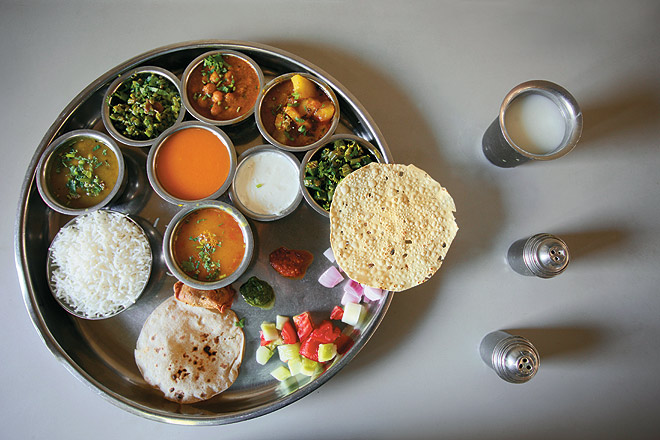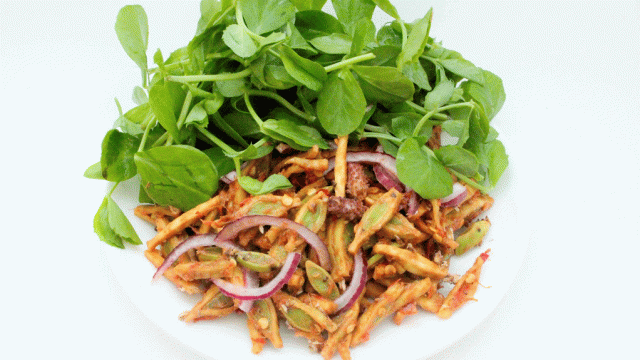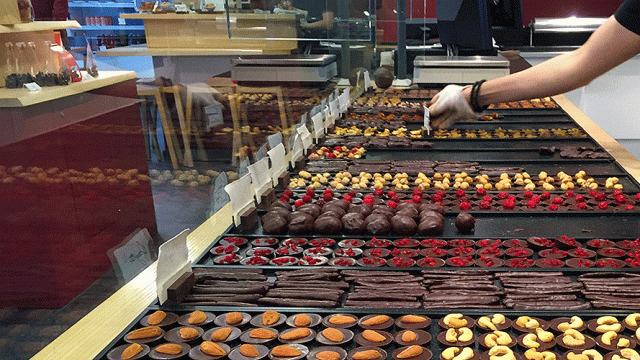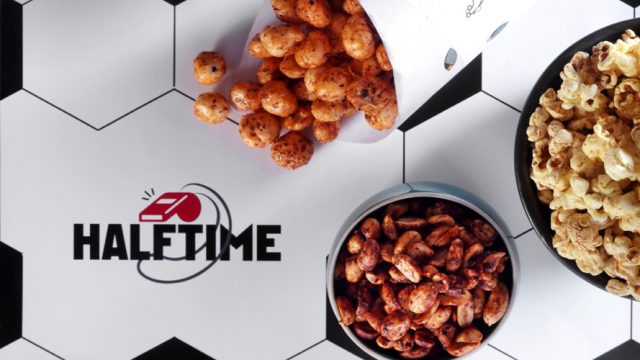Only the truly foolhardy would wander into Mumbai’s Shree Thaker Bhojanalay (022-22029916) on a whim. Or succumb
Savvy foodies approach this 55-year-old institution well armed: some bring a magazine to peruse in the Sunday-lunch queue; others carry digestive tablets in their pockets; while the spatially challenged may require a map, if not a GPS, to navigate the by-lanes of Kalbadevi. Above all, the Thaker regular comes equipped with a strategy as comprehensive as any takeover bid — along the lines of “Skip breakfast. Swim 80 laps. Wear baggiest clothes in wardrobe.”
It’s all worth it for a single reason: the food. Minutes after a table is finally occupied, the plonking, sloshing and force-feeding begins. A fiery, red garlic chutney, a spirited green chutney, immodestly orange pickles, salads and chopped green chillies are placed along the edge of an enormous thali. Then comes an array of sinful snacks — crunchy samosas, satiny khandvis, crisp mirchi bhajias or flavour-packed kachoris. Next in line is the waiter bearing an assortment of vegetables and pulses, which he ladles into four katoris. Another cheery soul spoons out addictive dahi kadhi and characteristic sweet dal. Then comes the enthusiast with the roti tray — ghee-kissed chapatis, little bajra rotlas, crumbly biscuit bhakris. Somewhere along the way, a glass of chaas appears, with bowls of creamy dahi and gulab jamuns. And before you can decide whether the mixed pulses are yummier than the potato, it’s time for tough decisions. Another biscuit bhakri or an extra mohanthal mithai? Khichdi or rice?
The procession and persuasion continue long after the diner has reached a state of burpy, bug-eyed befuddlement. “Only one more papad,” wheedles a waiter. Adds another ghee-wielding fellow in the tones of a solicitous granny, “Just a little rice and dal for tasting. But it won’t be good without ghee.” At the end of the meal, the manager apologises for the no-frills nature of the Rs 200 ‘limited thali’. “On Sundays,” he eagerly explains, “you get three unlimited sweets, puris and pulao as well.”
After which the customer lurches into the hot afternoon, experiencing the khichdi of emotions that a great Gujarati meal inevitably generates: contentment, somnolence and a greedy determination to head back on Sunday to make the most of those three unlimited sweets. For Gujarati cuisine is not just about versatile vegetarian food — it is as much about splashes of golden ghee, gluttony and the abiding belief that every tummy can expand to accommodate an extra puri and blob of strawberry shrikhand. Which is why Gautam Purohit — the son of Maganbhai, who started Thaker Bhojanalay and is known as the ‘Bhishma Pitamah of the Gujarati Thali’ — is actually delighted about the big eaters that he attracts: “We get people who eat all this and 20 katoris of aamras. Some customers eat 40 puranpolis or 60 malai sandwiches at a go.”
These indulgences explain why newbies head out for Gujarati thalis in the first place — never mind that the fare is vegetarian, the dal is almost as sweet as the walnut sheera, and the calories involved would fluster the average calculator. But they soon learn to appreciate the distinctive blend of sweet and tangy flavours, the careful use of seasonal vegetables and the incredible variety packed into a plate. And a few thousand calories later, they find themselves returning as much for the demure cauliflower peas or sweet potato bhaji as for the seductive mini rasgollas in rabdi.
After all, Gujaratis have been an integral part of Mumbai — especially its wholesale markets and narrow lanes packed with small businesses — for centuries. It makes sense then that authentic patra and kathol are available as easily at Crawford Market as they are in Kathiawad. And most foodies agree that the ‘Gujju Thali’ is one of the cheaper, yummier benefits of life in Mumbai.
Admittedly, many Gujarati dishes are just variations on a familiar theme — but then it’s the little details that transform Clark Kent into Superman. The traditional dal served at Gujarati weddings has a glorious sweet-and-sour flavour achieved with the help of jaggery, kokum and dried mango. The thepla — which is next only to ‘passports’ on the packing list of the travelling Gujarati — is a delicious, veggie-rich version of the paratha. Khichdi, which most Indians consider invalid slop, takes on many flavourful avatars in the Gujarati kitchen; sometimes it’s made from green moong, at other times a mix of yellow dals, and at still others from cracked wheat. Sometimes it’s tempered with chilly and spice, at others it’s topped with a layer of creamy dahi and baked. Little wonder, then that the Khichdi Samrat (22420344) restaurant in Bhuleshwar makes a living out of this single dish. Khichdi is normally served alongside kadhi — a pan-Indian concoction of besan (gram flour) and dahi. The version that comes from the parched, dazzling realms of Kutch and Saurashtra is thinner, paler and sweeter than its cousins.
There are, however, some dishes that are unique to the land of garba and ghagras. Dhoklas, those tiffin-box favourites, are made from steamed besan, while khandvis are melt-in-the-mouth rolls conjured up from besan and curds. These and other teatime treats are available at legendary eateries like Dave Farsan Mart (66578311) in Babulnath and Bhaishankar Gaurishankar (2386-3655) at CP Tank.
Less well known than these flamboyant farsans is panki, a delicate rice pancake steamed between banana leaves. Then there’s the heartier handvo, a roasted dish made of flour and vegetables. And that ultimate comfort food, dal dhokli — a one-dish meal achieved when diamond-shaped pieces of flour are simmered in a spicy dal. The best place to sample these is the two-hours-wait-on-Sunday-afternoons Swati Snacks (65808405) at Tardeo. Or even better, the home of a hospitable Gujarati friend who hasn’t yet junked her grandmother’s gatta nu shaak recipe in favour of cauliflower manchurian or veg lasagna.
The traditional Gujarati kitchen — especially one that is ruled over by an old-fashioned Brahmin Maharaj — remains a world of sizzling kadhais, plump pickle jars and immutable rules. Dr Meena Shah recalls a childhood spent under the tyrannical reign of these master cooks. “A part of our kitchen was slightly raised and only our Maharaj used this area. If we wanted something, the Maharaj would come out and give it to us. If one of us touched a single utensil or tried to serve ourselves, the Maharaj would not eat any food that day.”
When Dr Shah got married, she was relieved to find that the Rajasthani Maharaj who presided over her new home actually permitted the family to enter his domain. But the mere mention of non-vegetarian food gave him conniptions — compelling the family to set up a makeshift kitchen in the balcony so that an occasional egg could be boiled for the children. Adds another cowed soul, “Our Maharaj goes out of the house at 10am every morning. So in case the kids want eggs, I sneak into the kitchen, quickly make the eggs, wash and dry the pan and get rid of all evidence. It’s a lot of tension but I guess we put up with it because his food is fabulous. And he knows all the old customs and which dishes to make during which season.”
As summer approaches and crates of green and golden mangoes pile up at Crawford Market, Gujarati households go into a frenzy of haggling, sniffing, slicing and stirring. Raw mangoes are transformed into pickles like the sweet-and-tart chhundo and gorkeri. While ripe mangoes become the pivot of every meal — payri and rajapuri are squeezed into a pulp and consumed with puris and chapatis, alphonsos are eaten as a dessert, and even lesser varieties like langda go into tangy preparations like pakki keri nu shaak and kachi keri nu shaak (spicy dishes cooked using ripe and raw mangoes, respectively).
Not too long after the mangoes depart — leaving behind jars of hot and sweet pickles — it’s time to start planning the big-banner winter production. Beady-eyed cooks and housewives stalk the bazaars for surti papri, rajeri bananas, sweet potatoes, brinjals and yam. “We make 15 kilos of undhiyu every year,” says Bhavna Shah about the delicacy that is slowly cooked on a sigri. “We have to start planning and buying the ingredients weeks in advance. The whole family and all the staff is involved in cleaning the four kilos of papri. We pick up a handful whenever we are free or watching TV, and pull out the threads.”
But what can a single family do with 15kg of undhiyu — delicious though it might be? “We eat it for a week,” laughs Bhavna Shah. “And every year we make a list of different people to invite.”
Those who are not on this particular U-list need not despair. The eateries run by this enterprising community know how to sell their seasonal delicacies and their strengths. After all, only a marketing genius could have transformed the inconvenient Gujarati habit of eating numerous dishes in small quantities into the neatly packaged Gujarati thali.
Indeed, the early Gujarati eateries existed not to serve calorific feasts to foodies but basic meals to the many Gujarati shopkeepers and traders who lived in Bombay without their families. Friend’s Union Joshi Club (22058089), for example, was established over a hundred years ago to supply nutritious food to its members, who bought monthly passes. Even today, local history buffs and those who want a tasty but basic meal make their tedious way to this airy Kalbadevi institution, with its whirring fans and peanutty dal. Other hardy foodies continue to patronise Rajdhani (23449014) in the bustling heart of Crawford Market. (Incidentally, the name of this hugely popular thali restaurant seems to have emerged both from its speedy service — the waiters use a unique sign language to inform each other that Table No 3 wants more tindola chirya or another kela vada — and cramped, train-like interiors.)
Luckily, for those who don’t like plodding through clogged bylanes, excellent thalis are now available in swish surroundings as well. Rajdhani, for example, has burgeoned into a chain with outlets and “snacklets” at malls and theatres across the city. Status (22872821) at Nariman Point, Samrat (42135401) at Churchgate, Panchvati Gaurav (22084877) at Metro and Golden Star (23631983) at Opera House all have their vocal votaries.
Although these restaurants stick to traditional fare — at most throwing in an occasional cheese roll for variety — Gujaratis themselves are busy adding to their repertoires. Frequent foreign jaunts have yielded not just Swiss cowbells and ‘Mind the Gap’ T-shirts but innovative ideas for vegetarianising and masalafying all manner of foods — from fondue to falafel, sizzlers to spaghetti. Which is why Gujarati wedding caterers like Thackers (23649300) at Chowpatty offer Thai, Burmese and Wok counters and crostini and panini sandwich bars as a matter of course. And startling new hybrids like ‘Sizzling Vegetable Aloo Chilli’, ‘Pav Bhaji Pizza’ and ‘Dhokla Manchurian’ are being born at a rapid rate. Guj-Tex-Mex and Saurashtra-Schezuan, however, belong to another, less happy story — and offer little competition to stuffed patra, aloo subji with dry fruit and dal cooked with mango.
Indeed, few vegetarian meals are as exciting as the Gujarati magnum opus, with its clashing colours, contrasting flavours and varied textures. Only remember to leave your guilt and snug-fit jeans at home — and to nod your cheerful acquiescence every time the ghee pot comes around.
Gujarat
Gujarati cuisine
Gujarati thali





